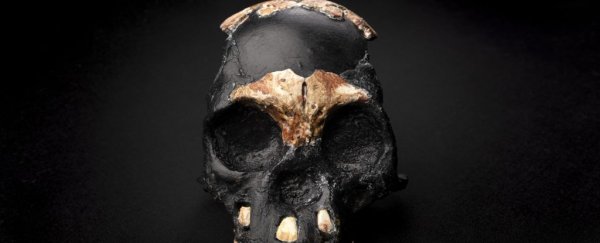The discovery of fragments of a child's skull in a hard-to-access cave in South Africa is reigniting speculation that human ancestors paid special attention to their dead – a ritual that at some point came to separate us from other animals.
By some accounts, South Africa's Rising Star Cave system represents a turning point for humanity, when hominids first took their dead and hid them away from the elements.
Evidence in favor of deliberate interment at the site has so far been circumstantial at best. But the new discovery of a few pieces of a skull tucked into a crevice could persuade a few more anthropologists to take the possibility seriously.
The fragments belong to a young Homo naledi – an extinct species of human of which we know surprisingly little about. This is in spite of the fact that the species' discovery a little under 10 years ago involved the uncovering of a relatively massive trove of remains.
Since then, nearly 2,000 bits of bone left by at least two dozen have been sifted from the Rising Star Cave's sediments.
From them we can determine a few facts. One is they represent a species with the archaically small brains and robust build of an Australopithecus, blended with a variety of more modern human characteristics. Another is that they all died anywhere between 236,000 and 335,000 years ago.
Then there is one other clue, one concerning their way of life. The area in which they were found, called the Dinaledi Chamber, isn't easy to get into, raising the possibility that the collection of bodies were somehow deposited there by members of their own community.
It's a claim that divided experts when raised at a meeting of the American Association of Physical Anthropologists in 2016. Even the paleoanthropologist who led the discovery, Lee Berger of the University of the Witwatersrand in Johannesburg, wasn't keen on jumping to conclusions.
"It's way too early to tell how H. naledi bodies got in the chamber," Berger said, according to Bruce Bower from Science News.
Berger and his team have now published a new study, this time on a rather special set of H. naledi remains they named Leti, (pronounced 'let-e'), from a Setswana word meaning "the lost one".
Without a clear idea of how fast the species develops, the researchers could only guess at Leti's age. Compared with similar fossils, its teeth put it into a category of "early juvenile". Yet its brain, estimated at roughly 480 to 610 cubic centimeters in volume, would have been close to fully grown. By comparison our own adult brains typically exceed 1,000 cubic centimeters.
"The size of Leti's brain makes it very comparable to adult members of the species found so far," says anthropologist Debra Bolter, a co-author on the study and specialist in growth and development from the University of the Witwatersrand.
The find contributes vital details to our knowledge of this 'mosaic' of archaic and modern human. But it's Leti's unusual place of rest that continues to inspire curiosity over how it came to be inside the caves in the first place.
Similar to the remains of one adult male found previously, the child was found inside a rather tight passage; a shelf about 12 meters (about 39 feet) beyond the Dinaledi Chamber that was a mere 15 centimeters (barely half a foot) across and 80 centimeters (31 inches) deep.
Without clear signs of predation or the influence of water, it's hard to imagine how the bones got there. So far just the skull has been found, making any solid conclusions even harder to form.
Remains of other animals have been found deep inside the cave system, including the teeth of baboons, suggesting it might not be a huge surprise to find traces of a few lost humans in there as well.
The fact none of the baboon bones are within the same layers as the human bones though, coupled with the relatively large number of H. naledi bodies and their specific locations, only adds to the mystery.
"The discovery of a single skull of a child, in such a remote location within the cave system adds mystery as to how these many remains came to be in these remote, dark spaces of the Rising Star Cave system," says Berger.
"It is just another riddle among many that surround this fascinating extinct human relative."
We know that at some time in our past humans adopted funerary practices.
Following the recent discovery of a three-year-old child in a South Kenyan cave dating back 78,000 years, a body we can say with confidence was deliberately interred, it's clear the practice is one that dates back at least tens, if not hundreds of thousands of years for our own species.
It's also becoming increasingly accepted that Neanderthals had their own funerary practices, further supporting the view that our cultural heritage doesn't have a monopoly on burying the dead.
But the precise reasons, and methods, behind the very first burials could be much harder to tease out of the fossil record.
Similar to 430,000-year-old deposits of remains in Spain's Sima de los Huesos, thought by some to have been left by ancestors closely related to the Denisovans, the Dinaledi Chamber bones can only invite us to ask questions over what it means to be human.
This research was published in PaleoAnthropology here and here.
